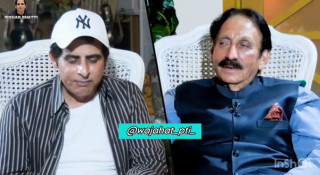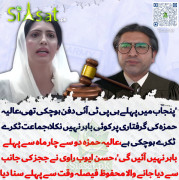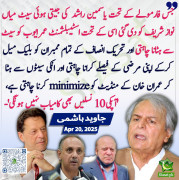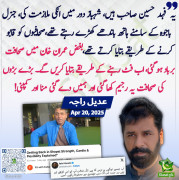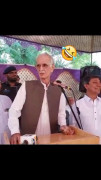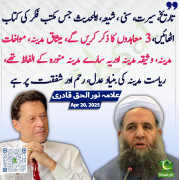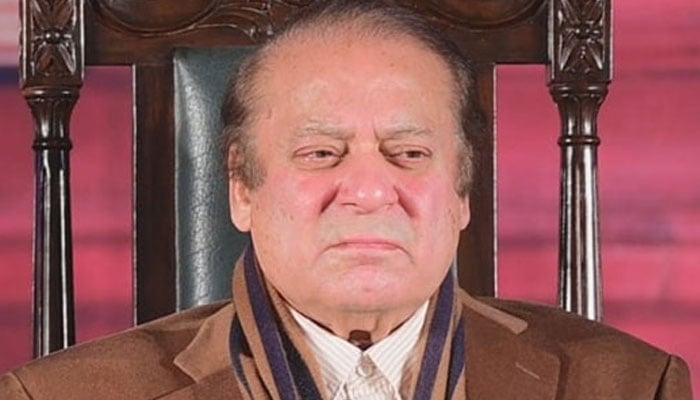
US officials think Zardari?s days are numbered: NYT
Tarin paints bleak picture of economy
Thursday April 02, 2009 (0611 PST)
NEW YORK: In a detailed report based on an interview of President Asif Ali Zardari, the New York Times says the president damaged himself over the long march, Nawaz Sharif has emerged stronger and American officials are increasingly convinced that Zardari is not the interlocutor they had hoped for and that his days in power may be numbered.
The article written by James Traub under the title ?Can Pakistan be governed?? to be published on April 5 in NYT Magazine, said US officials have begun to pay more attention to Sharif, long considered dangerously close to Islamist forces.
When President Zardari was asked if he had learnt any lessons from the previous week, he pondered. ?Every day,? he said, ?Man is growing and learning. What you were yesterday, you are probably not today, because today?s you are yesterday?s experience. One is always learning.? Indeed, one is,? the NYT said.
Followng is the full text of the NYT article: ?To enter the office where Asif Ali Zardari, the president of Pakistan, conducts his business, you head down a long corridor towards two wax statues of exceptionally tall soldiers, each in a long, white tunic with a glittering column of buttons. On closer inspection, these turn out to be actual human beings who have been trained in the arts of immobility. The office they guard, though large, is not especially opulent or stupefying by the standards of such places. President Zardari met me just inside the doorway, and then seated himself facing a wide screen TV displaying an image of fish swimming in a deep blue sea. His party spokesman, Farhatullah Babar and his presidential spokesman, Farahnaz Ispahani, sat facing him, almost as rigid as the soldiers. Zardari is famous for straying off message and saying odd things or jumbling facts and figures. He is also famous for blaming his aides when things go wrong - and things have been going wrong quite a lot lately. Zardari?s aides didn?t want him to talk to me. Now they were tensely waiting for a mishap.
The president himself, natty in a navy suit, his black hair brilliantine to sheen, was the very picture of ease. Zardari beamed when we talked about New York, where he often lived between 2004, when he was released from prison after eight years, and late 2007, when he returned to Pakistan not long after his wife, Benazir Bhutto, was assassinated by terrorists. For all that painful recent history, Zardari is a suave and charming man with a sly grin, and he gives the impression of thoroughly enjoying what must be among the world?s least desirable jobs. Zardari had just been through the most dangerous weeks of his six months in office. He dissolved the government in Punjab, Pakistan?s dominant state, and called out the police to stop the country?s lawyers and leading opposition party from holding a ?long march? to demand the reinstatement of Chief Justice Iftikhar Muhammad Chaudhry, who had been sacked, along with most of the high judiciary, by Zardari?s predecessor, Gen Pervez Musharraf. Zardari defused the situation only by allowing Chaudhry?s return to office and giving in to other demands that he had previously and repeatedly rejected.
Yet, despite this spectacular reversal, the president was not in a remotely penitent state of mind over his handling of the protests against him. ?Whoever killed my wife was seeking the Balkanization of Pakistan,? he told me. ?There is a view that I saved Pakistan then? - by calling for calm at a perilous moment - ?and there is a view that by making this decision I saved Pakistan again.? There had been, he said, a very real threat of a terrorist attack on the marchers on their way to Islamabad. That is why his government invoked a statute dating back to the British Raj in order to authorize the police to arrest protesters and prevent the march from forming. I pointed out that Benazir Bhutto faced a far more specific threat and was outraged when General Musharraf kept her from speaking on the pretext of protecting her. The president didn?t miss a beat. ?And therefore,? he rejoined, ?We moved to the other side?: that is, he reversed his order to the police, and permitted the protesters? march, just before giving in to their demands altogether.
Zardari has a special talent for maneuvering himself out of the tight spots he gets himself into. But the Pakistani people have grown weary of his artful dodging. Zardari?s poll numbers are dreadful. More important, he has given little sustained attention to the country?s overwhelming problems - including, of course, the Islamist extremism that, for the Obama administration, has made Pakistan quite possibly the most important, and worrisome, country in the world. Zardari has bought himself more time, but for Pakistan itself, the clock is ticking louder and louder.
When I arrived in Islamabad on March 10, the long march was set to begin in two days and had come to feel like a storm gathering force at sea - one that might peter out before it hit land or turn into a Category 4 hurricane. In a country where democracy feels as flimsy as a wooden shack, the foreboding was very real. ?Our condition is much more fragile than it was in the 1990s,? Samina Ahmed, the International Crisis Group?s longtime Pakistan analyst, told me. (The ICG is a sponsor of the Global Center for the Responsibility to Protect, where I am the policy director.) The Taliban and other extremists had, she estimated, placed half the country beyond the control of security forces. The government had recently ceded control over the Swat valley, 100 miles from the nation?s capital, to the extremists.
Pakistan feels as if it?s falling apart. Last fall the country barely avoided bankruptcy. The tribal areas, which border on Afghanistan, remain a vast Taliban sanctuary and redoubt. The giant province of Balochistan, though far more accessible, is racked by a Balochi separatist rebellion, while American officials view Quetta, Balochistan?s capital, as Taliban HQ. American policy has arguably made the situation even worse, for the Predator-drone attacks along the border, though effective, drive the Taliban eastward, deeper into Pakistan. And the strategy has been only reinforcing hostility to the United States among ordinary Pakistanis.
Pakistan has made itself the supreme conundrum of American foreign policy. During the campaign, Obama often said that the heart of the terrorist threat was not Iraq but Afghanistan and Pakistan, and once in office he had senior policy makers undertake an array of reviews designed to coordinate policy in the region. They seem to have narrowed the target area even further, to the Pakistani frontier. ?For the American people,? Obama announced on March 27, ?This border region has become the most dangerous place in the world.? Some officials see Pakistan as a volcano that, should it blow, would send an inconceivable amount of poisonous ash raining down on the world around it. David Kilcullen, a key adviser to Gen David Petraeus, the Centcom commander, recently asserted that ?within one to six months we could see the collapse of the Pakistani state,? a calamity that, given the country?s size, strategic location and nuclear stockpile, would ?dwarf? all other current crises.
And amid all that, Pakistan?s president appeared to be playing with fire. Zardari was setting his security forces on peaceful demonstrators, just as his authoritarian predecessor, General Musharraf, did - against members of Zardari?s own political party - several years earlier. The government crackdown, designed to prevent the marchers from reaching the capital, began on March 11. The police swept through the homes of opposition party leaders, lawmakers, activists, ?miscreants? and ordinary party workers. Many leading officials were already underground, but hundreds of arrests were made. By the 12th, the first day of the march, much of the country was glued to the television, where swarms of heavily armed policemen could be seen knocking down protesters and dragging them off to the paddy wagons. Nawaz Sharif, the leader of the main opposition party, saw the protests as the ?prelude to a revolution,? while Rehman Malik, a key Zardari adviser, accused Sharif of ?sedition.?
The posturing and hyperbole would have been comical if the stakes weren?t so high. Although in Pakistan, it?s true, the stakes always feel high.
For the last two years, Pakistan has been living through a dangerous and thrilling era of popular agitation and spasmodic crackdown. In March 2007, General Musharraf made the colossal miscalculation of insisting that Chief Justice Iftikhar Chaudhry, whose activism on the bench had threatened the military?s invulnerability to legal prosecution, step down. In decades past, judges quietly acceded under such duress, and Musharraf may be excused for calculating that Chaudhry, an unassuming figure, would do likewise. Instead, the chief justice stood up to the president, who then fired him, creating a national hero of resistance. Tens of thousands of people lined the roads and cheered as Chaudhry barnstormed across the country - an astonishing sign of Pakistanis? craving, after years of repression, for democracy and the liberal principles established in Pakistan?s constitution.
That October, under intense domestic and American pressure, Musharraf agreed to permit Benazir Bhutto, who had been living in Dubai, to return. Bhutto and her chief rival, Nawaz Sharif, had been exiled from Pakistan since their respective terms as prime minister. But their political parties - Sharif?s Pakistan Muslim League-Nawaz (PML-N) and Bhutto?s Pakistan Peoples Party (PPP) - continued to operate under Musharraf, and their partisans waited for the return of their leaders to revive the nation?s democratic politics.
Two months after her arrival, Bhutto was killed in an attack in Rawalpindi. Her death was experienced as a national calamity - both a terrifying proof of the growing reach of terrorism inside Pakistan and a grave blow to the country?s democratic hopes. Three days later, the PPP - an arm of the Bhutto family since its founding by her father 40 years earlier - chose her widower, Zardari, and their 19-year-old son as co-chairmen, the elder acting in effect as regent for the younger. In elections seven weeks later, the PPP, buoyed by sympathy over Bhutto?s death and vowing to take up the cause of the deposed judges, won. It formed a coalition government that included regional allies and Sharif?s PML-N. Here, at last, was a chance for a new beginning.
In May 2006, Bhutto and Sharif met in London to sign a document known as the Charter of Democracy. The two vowed to rescind a raft of amendments that military rulers had added to the constitution, including several that empowered the president at the expense of the prime minister, and to establish a merit-based system for picking judges (a practice neither Bhutto nor Sharif even remotely favored while in office). But Zardari seemed much less interested in these constitutional questions than Sharif, who made the restitution of judges a centerpiece of his campaign. (He compelled all of his party?s parliamentary candidates to swear an oath before him demanding that the judges be restored.)
In May 2008, less than three months after the government was formed, Sharif pulled his ministers from the cabinet. But he continued pressing Zardari to abide by the spirit of the Charter of Democracy. On Aug 7, Zardari signed a document pledging that a ?nonpartisan? figure would assume the presidency and that this person would restore the judges shortly after taking office. When it became clear, in late August, that Zardari himself would become president, an irate Sharif withdrew from the coalition altogether.
On Sept 9, Zardari became president of Pakistan and proceeded to ignore his promise to restore the judges. I asked Zardari how he could have done so. He explained that since General Musharraf had agreed to resign rather than face impeachment proceedings, ?everybody goes back to start afresh.? Apparently this was, in Zardari?s mind, a special kind of pact that ceased to be binding when one party concluded that the circumstances under which it had been accepted had changed. Zardari kept nibbling away at this perplexing concept. The document he had signed was ?an agreement by consent,? not ?an agreement by law.? It was like a marriage. It was like a merger. I said that I wondered if Sharif would agree; he may well have thought that Zardari had, in fact, bound himself to act with dispatch. ?Maybe that might be the interpretation assumed by him,? the president conceded.
Zardari did win a partial victory: he persuaded 57 of the remaining 63 high court judges to take a new oath in order to be restored to office. But the other six, including Chaudhry, refused to do so, on the grounds that, as they had been unconstitutionally deprived of office, the oaths they swore earlier remained in force. Early this year, the lawyers began planning their march, which was to terminate with a sit-in in Islamabad. The government would be able to dismiss a sit-in among lawyers as a nuisance; only with the active involvement of the PML-N, with its vast rank and file and its control over the Punjab state apparatus, would the protest truly pose a threat to Zardari. In mid-February, the PML-N agreed to join the lawyers not only for the planned march but also for the sit-in, which held far greater potential for confrontation.
Ten days later, on Feb 25, the Supreme Court, led by Chief Justice Abdul Hameed Dogar - whom Musharraf had elevated to replace Chaudhry, and whom Zardari had consistently supported (rumors abound of late-night conversations between them in the president?s house) - abruptly issued a decision on a case that had been pending for eight months, finding that Nawaz Sharif and his brother Shahbaz, the chief minister of Punjab, could not hold elective office because they had previously been convicted of crimes. It was widely assumed that Zardari engineered this outcome to end PML-N control over Punjab. That very evening he gave substance to these suspicions by suspending Punjab?s elected government in favor of rule by the governor, a federal appointee. This combination of moves had the appearance of a coup. It caused outrage in the Punjab, in the ranks of the PML-N and throughout the country.
When I asked Zardari why he had imposed governor?s rule, he embarked on another adventure in logic. ?No democratic party would like to do governor?s rule,? he said. ?It?s in the constitution; it?s part of necessity. The government advised me to put governor?s rule, and I took their advice, as I am bound by the constitution to accept the advice from the government.? The official line is that, with the local government dissolved and no single party in the majority and thus able to form a new government, Islamabad had to step in. In fact, in such situations the constitution requires the governor to ask the largest party to seek to form a majority - as the PML-N surely would have done - although the president does have the right to impose governor?s rule if he judges the province to be unstable.
End.

